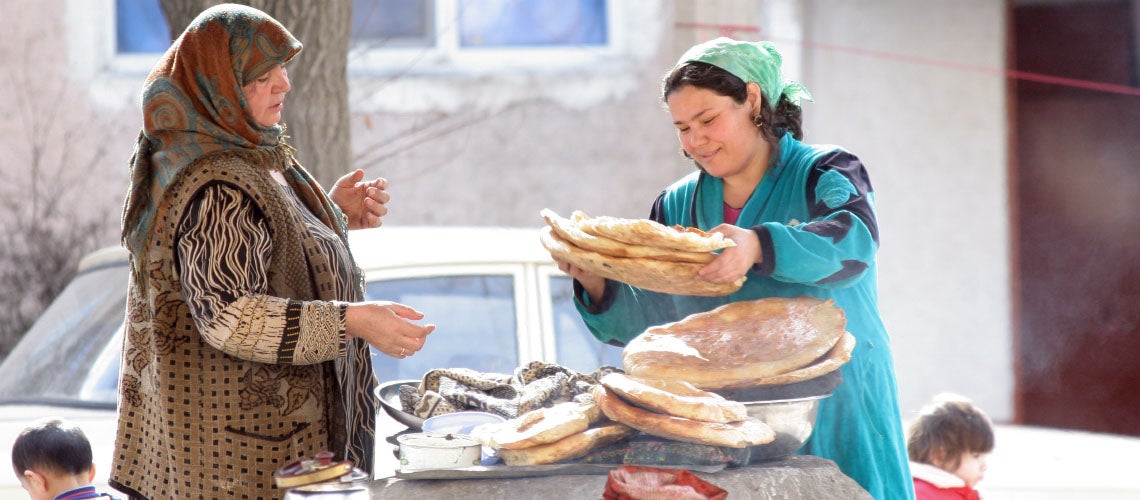 Woman selling traditional bread in Tajikistan.
Woman selling traditional bread in Tajikistan.
In marking International Women’s Day across Europe and Central Asia, we must recognize that there is still much progress to be made on gender equality in the region. In Tajikistan, women face significant obstacles in the country’s labor market. Our recent Country Gender Assessment reveals just how stark the gender gap is :
- Women contribute just one-fourth of the country’s gross national income (GNI). Estimates, based on the Gender Development Index methodology, suggest that in 2019 earned income per capita for men in Tajikistan was $6,427 (in 2017 PPP terms), compared to only $1,440 for women. It is also worth mentioning that while GDP and GNI are good approximations for economic welfare and progress, they mainly measure market production and hence underestimate the contribution to household welfare of activities at home such as childcare, cooking, and cleaning, the burden of which is disproportionately borne by women.
- Women are more likely to be unemployed: 69% of working-age women are not working for pay, compared to 49% of men.
- Young women are less likely to be employed or in school: 49% of women aged 15-24 in Tajikistan are not in education, employment, or training (NEET) compared to 7% of men. Regional breakdowns confirm that youth female NEET rates are higher than youth male NEET rates across the entire country.
- Women are paid less: Records indicate that the average nominal monthly wage (irrespective of job type) has been consistently higher for men than for women across all sectors of the economy. Economy-wide, women earned 60% of what men earned in 2017 or 2018 (Figure 1).
Undoubtedly, social norms and domestic violence can also negatively impact women’s employability. According to a recent survey among young people, respondents asserted a school-level education was sufficient for girls to be good mothers and wives. Other studies suggest that almost half of women become inactive in the labor market after leaving education due to social norms.
While not unique to Tajikistan, the observed gender gap in Labor Force Participation Rate (LFPR) is much larger than in comparator countries. Figure 2 shows that Tajikistan’s 21.5% gender LFPR gap is higher than the average for low-income countries (15.3%) and the Europe and Central Asia region (16.1%).
Identifying Areas for Reform
Tajikistan improved its ranking on the Women, Business and Law (WBL) index thanks to the introduction of domestic violence legislation in March 2013 and adoption of the new Labor Code in July 2016 that allows women to work the same night hours as men. However, despite women facing fewer legal constraints today compared to a decade ago and compared to the rest of the Central Asia, there is still room for improvement on the regulatory side (Table 1).
Table 1. Performance on the Women, Business, and the Law (WBL) Index, 2022
| 2022 Score |
WBL |
Mobility |
Work- |
Pay |
Marriage |
Parent- |
Entrepre- |
Assets |
Pension |
|---|---|---|---|---|---|---|---|---|---|
| Tajikistan |
78.8 |
100 |
50 |
50 |
100 |
80 |
100 |
100 |
50 |
| Tajikistan |
73.1 |
100 |
50 |
25 |
80 |
80 |
100 |
100 |
50 |
| Kazakhstan |
69.4 |
100 |
50 |
25 |
100 |
80 |
75 |
100 |
25 |
| Kyrgyz |
76.9 |
100 |
100 |
25 |
100 |
40 |
100 |
100 |
50 |
| Uzbekistan |
70.6 |
100 |
50 |
25 |
80 |
60 |
100 |
100 |
50 |
| OECD |
77.5–100 |
100 |
50-100 |
25-100 |
60-100 |
60-100 |
75-100 |
60-100 |
50-100 |
Source: World Bank (2022).
Note: A score of 100 means that women do not face legal constraints. The index is structured around eight topics (mobility, workplace, pay, marriage, parenthood, entrepreneurship, assets, and pension), which measure the degree to which women face legal constraints at different stages of their lives.
According to the latest 2022 WBL report, Tajikistan could consider further reforms to improve legal equality for women in such areas as women's decisions to work, women's pay, women's work after having children, and the size of a woman's pension. In the area of women’s decision to work, Tajikistan may wish to consider enacting legislation protecting women from sexual harassment in employment, and adopting criminal or civil penalties for sexual harassment in employment.
Many factors contribute to low female labor force participation rates in Tajikistan, but one of the most significant is the country’s Labor Code. Article 216 prohibits women’s employment in: underground jobs, difficult jobs, jobs in harmful conditions, or jobs linked to manual lifting and moving of heavy loads. The list of specific sectors and professions where female employment was not allowed was originally established by Ordinance No. 240 of 25 July 1978, and remained in force until the new restrictive list was established by the Government Resolution No. 179 of 4 April 2017. The Resolution largely mimicked the Soviet Ordinance by preserving the archaic nature of job restrictions. Women are excluded from numerous professions and tasks perceived to be harmful or difficult in around 27 sectors of the national economy, including construction, mining, geological exploration and topography, railway transport and subways, and even agriculture.
Level of education also plays an important role in the ability of women to find work. Demography and Health Survey finds that in Tajikistan women with no education or only primary education are three times less likely to be employed compared to women with higher education (18% vs. 54%).
Increased male labor migration over the last two decades has been another important contributing factor. Men migrated abroad in large numbers in the 2000s, mostly to Russia, in search of better employment opportunities. That meant that women were increasingly called upon to become full-time housekeepers. Focus group interviews reveal that when young women have children to take care of, or in some cases their families ban women from working outside the home, then women do not look for a job, despite having a good education and marketable skills.
So, what can be done to raise female labor force participation rate in Tajikistan? The country can take several measures, such as:
- Further remove regulatory restrictions
- Introduce quotas for women for public sector jobs
- Organize soft-skills training for women to help them with more effective job-search
- Introduce anti- sexual and gender-based violence (SGBV) harassment policies in workplaces
- Organize tailored trainings for youth who are not in education, employment, or training
- Introduce paternity leaves in employment regulation
- Ensure gender equality in retirement ages
- Conduct awareness raising and advocacy campaigns, including by involving religious leaders, with the public on the importance of equal economic opportunities for women
Removing restrictions on women’s employment and expanding economic opportunities in Tajikistan is likely to yield many benefits: enhancing women’s earnings potential by widening access to jobs in higher-paying sectors, expanding employment opportunities for both men and women, and helping promote occupational integration and greater flexibility in the labor market. It would also speed up poverty reduction — numerous studies confirm that income from employment has been one of the main drivers of poverty reduction worldwide.
But most importantly, removing such gender-based employment restrictions would promote a more inclusive economy in Tajikistan, one where women are better able and empowered to tap into their full human potential.
Related reading and data sources:
- Tajikistan – Country Gender Assessment (2021)
- Country Partnership Framework for Tajikistan for the period FY 2019-23 (2019)
- HDR 2020 Technical Note
- Jobs Diagnostic: Tajikistan (2016)
- Macro-poverty outlook – Tajikistan (2021)
- Situation in the Labor Market of Tajikistan – Russian version (2017)
- Tajikistan Demographic and Health Survey (2017)
- Women, Business, and the Law (2022)
- Agency for Statistics under the President of Tajikistan
- World Bank: World Development Indicators





Join the Conversation